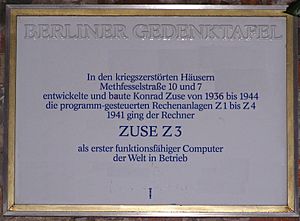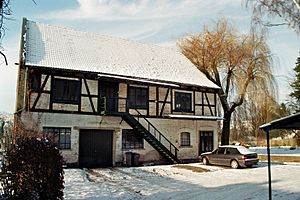Konrad Zuse facts for kids
Quick facts for kids
Konrad Zuse
|
|
|---|---|

Konrad Zuse in 1992
|
|
| Born |
Konrad Ernst Otto Zuse
22 June 1910 |
| Died | 18 December 1995 (aged 85) Hünfeld, Hesse, Germany
|
| Alma mater | Technical University of Berlin |
| Known for |
|
| Awards |
|
| Scientific career | |
| Fields | |
| Institutions | Aerodynamic Research Institute |
| Signature | |
Konrad Ernst Otto Zuse (22 June 1910 – 18 December 1995) was a German civil engineer, computer expert, inventor, and businessman. He is famous for creating the world's first working programmable computer. This amazing machine, called the Z3, started working in May 1941.
Because of his inventions, Zuse is often called the "father of the modern computer." He also built the S2, which was the first computer used to control processes. In 1941, he started one of the first computer companies. His company made the Z4, which was the world's first computer sold to a customer.
From 1943 to 1945, Zuse designed Plankalkül. This was the very first high-level programming language. In 1969, he even suggested that the whole universe might work like a computer! He wrote about this idea in his book Calculating Space.
Much of his early work was paid for by his family and businesses. Later, during World War II, the German government helped fund his projects. Because of the war, many people in other countries like the United Kingdom and the United States didn't know about his work.
Contents
Early Life and Education
Konrad Zuse was born in Berlin, Germany, on June 22, 1910. When he was two years old, his family moved to Braunsberg, where his father worked for the post office.
In 1923, his family moved again to Hoyerswerda. He finished high school there in 1928. After that, he went to the Technical University of Berlin. He studied engineering and architecture, but found them boring. He then decided to study civil engineering and graduated in 1935.
Konrad Zuse's Career
After finishing university, Zuse worked for the Ford Motor Company. He used his artistic skills to design advertisements. Later, he became a design engineer at the Henschel aircraft factory near Berlin.
At the factory, he had to do many calculations by hand. This made him think about how machines could do these tasks instead.
Starting in 1935, he began building computers in his parents' apartment in Berlin. In 1936, he made his first computer, the Z1. It was a mechanical calculator that used binary numbers and could be programmed. It read instructions from a special film.
In 1937, Zuse filed two patents that described ideas similar to modern computer designs. He finished the Z1 in 1938. It had about 30,000 metal parts. However, it didn't work very well because the parts weren't made precisely enough. On January 30, 1944, the Z1 and its plans were destroyed during a World War II air raid.
Zuse worked on his computers mostly by himself. From 1936 to 1945, he was quite isolated from other computer scientists.
Building Computers During World War II (1939–1945)
In 1939, Zuse was called to serve in the Wehrmacht (the German military). However, he was given resources to continue building computers, which led to the Z2. In September 1940, Zuse showed the Z2 to experts. The Z2 was an improved Z1 that used telephone relays for its parts.
The German government started funding Zuse and his company in 1940. They used his work for making glide bombs. Zuse built the S1 and S2 computers. These were special machines that calculated how to correct the wings of radio-controlled bombs. The S2 was the first computer that could control a process.
In 1941, Zuse started his own company, Zuse Apparatebau. He rented a workshop in Berlin to build his machines.
Later in 1941, he improved the Z2 and built the Z3. On May 12, 1941, Zuse showed the Z3 to the public. The Z3 was an electromechanical computer that used binary numbers and telephone relays. It could be programmed with loops. Even though it didn't have "conditional jumps" (a way for programs to make decisions), it was a very powerful computer. Zuse didn't know about Alan Turing's work at the time.
The Z3 was the first fully working electromechanical computer. The German government helped pay for it because they wanted to automate their calculations. Zuse's workshop, where the Z3 was located, was destroyed in an air raid in late 1943. His parents' apartment with the Z1 and Z2 was destroyed in early 1944.
However, the next computer, the Z4, which Zuse started building in 1942, remained safe. On February 3, 1945, heavy bombing in Berlin stopped Zuse's work. The partly finished Z4 computer was then moved from Berlin to Göttingen.
These machines helped develop guided missiles used by the German military. Zuse thought these machines were captured by Soviet troops in 1945.
While working on the Z4, Zuse realized that writing programs in machine code was too hard. He started working on a new idea: the first high-level programming language called Plankalkül. He also designed the first real computer chess program as an example.
After World War II (1945–1995)
After the bombing in 1945, Zuse fled Berlin to a rural area. It was very difficult to build computers in Germany after the war.
Zuse started one of the first computer companies, Zuse-Ingenieurbüro Hopferau. He got money in 1946 from ETH Zurich and a deal with IBM for his patents.
In 1947, Zuse met Alan Turing, another famous computer pioneer, in Göttingen. They talked about computers and their ideas.
It wasn't until 1949 that Zuse could continue working on the Z4. He showed the computer to a mathematician named Eduard Stiefel from the Swiss Federal Institute of Technology Zurich. Stiefel ordered a Z4 in 1950. In November 1949, Zuse founded Zuse KG, his new company. The Z4 was delivered to ETH Zurich in July 1950 and worked very well.

The Z4 was the only working computer in Europe at that time. It was also the second computer ever sold in the world. Zuse and his company built many other computers, up to Z43. The Z11 was sold to optics companies and universities. The Z22 was the first computer to use magnetic storage for memory.
Zuse couldn't develop new hardware for a while, so he kept working on his programming language, Plankalkül. He published parts of his work in 1948 and 1959, but the full work wasn't published until 1972. His PhD thesis was rejected because he forgot to pay a fee, but he didn't mind.
Plankalkül influenced the design of another programming language called ALGOL 58. However, Plankalkül itself was only fully put into practice in 1975. Some computer scientists wondered what would have happened if Zuse's work had been published earlier.
In 1956, Zuse started working on a very precise drawing machine called a plotter. He showed it at a fair in 1961. It became famous because artists used it to create early computer art.
In 1967, Zuse suggested that the universe might work like a giant computer program. He published this idea in his 1969 book, Calculating Space.
Between 1989 and 1995, Zuse designed and built a mechanical tower that could extend and retract. He called it the "helix tower" (Helixturm). It used gears to build a tube-shaped tower from stored parts. It could also take the tower apart. In 2009, a museum restored Zuse's model of this tower. Zuse imagined a full-sized tower that could be 120 meters tall, used for wind power or radio.
Between 1987 and 1989, Zuse rebuilt the Z1 computer. It cost a lot of money and took four people, including Zuse, to put it together.
Family Life
Konrad Zuse married Gisela Brandes in January 1945. They had a special wedding ceremony. Their first child, Horst, was born in November 1945. They had five children in total.
Zuse was never a member of the Nazi Party. He later said that scientists often have to choose between working for businesses or military groups, or not doing their work at all.
After Zuse retired, he spent his time painting. He signed his paintings with the name "Kuno See."
Konrad Zuse died on December 18, 1995, in Hünfeld, Germany, from heart failure.
Awards and Recognition
Konrad Zuse received many awards for his important work:
- Werner von Siemens Ring in 1964.
- Harry H. Goode Memorial Award in 1965.
- Wilhelm Exner Medal in 1969.
- Order of Merit of the Federal Republic of Germany in 1972.
- Computer History Museum Fellow Award in 1999 for inventing the first program-controlled computer and the first high-level programming language.
The Zuse Institute Berlin, a research center, is named after him.
Two medals, the Konrad Zuse Medal of the Gesellschaft für Informatik and the Konrad Zuse Medal of the Zentralverband des Deutschen Baugewerbes, are also named in his honor.
A copy of the Z3 computer and the original Z4 are displayed in the Deutsches Museum in Munich. The Deutsches Technikmuseum in Berlin has an exhibition about Zuse. It shows twelve of his machines, including a copy of the Z1, and some of his paintings.
Many events, lectures, and workshops were held to celebrate the 100th anniversary of his birth.
See also
 In Spanish: Konrad Zuse para niños
In Spanish: Konrad Zuse para niños
- Z5
- Z23
- Z25
- List of pioneers in computer science
- John Vincent Atanasoff
- German inventors and discoverers
- Reverse Polish notation
- Self-replicating machine (Montagestraße SRS 72, Helixturm)








